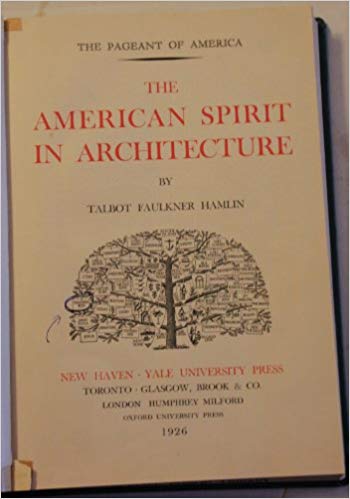Background
Talbot Faulkner Hamlin was born on June 16, 1889, in New York, United States. He was the son of Alfred Dwight Foster and Minnie Florence (Marston) Hamlin.

Amherst College 220 South Pleasant Street Amherst, MA 01002
Hamlin received Bachelor of Arts degree at Amherst College in 1910.
1172 Amsterdam Ave, New York, NY 10027, USA
In 1914, Hamlin received Bachelor of Architecture at Columbia University School of Architecture.
28 N College St, Carlisle, PA 17013, USA
Hamlin received an honorary degree of Doctor of Science at Dickinson College, in 1952.
The largest portion of the collection relates to Hamlin's academic life as an architectural historian and educator from 1916, when he accepted his first position at Columbia University, until 1955.





(This volume deals with The American Spirit in Architectur...)
This volume deals with The American Spirit in Architecture. It is part of the set titled: The Pageant of America.
https://www.amazon.com/Pageant-America-American-Spirit-Architecture/dp/0686834658/?tag=2022091-20
1926
architect educator writer author
Talbot Faulkner Hamlin was born on June 16, 1889, in New York, United States. He was the son of Alfred Dwight Foster and Minnie Florence (Marston) Hamlin.
Hamlin received Bachelor of Arts degree at Amherst College in 1910. Then, in 1914, he received Bachelor of Architecture at Columbia University School of Architecture and honorary degree Doctor of Science at Dickinson College, in 1952.
Upon graduation, Hamlin was hired as a draftsman in the New York architectural firm of Murphy and Dana. In 1916, he became an instructor of the Columbia School of Architecture, and then, he became a lecturer. He served there until 1947. In 1930, Hamlin began his own firm, which lasted until the Depression, when commissions became scarce. During his years as a professional architect, Hamlin participated in various projects, mainly located in the United States and Asia, including China, Japan, Korea, the Philippines. The bulk of his projects in the United States were residential and institutional (schools and churches), while projects in Asia were institutional (schools and monuments) and commercial.
Hamlin’s academic career began in 1916 when he was appointed a part-time instructor of architectural history and theory in the School of Architecture at Columbia University. In 1934, he relinquished his professional practice and accepted the full-time position of Avery Librarian for the Avery Architectural and Fine Arts Library at Columbia University. Among his major contributions to Avery Library, Hamlin established the Avery Index to Architectural Periodicals. Hamlin remained librarian until 1945 when he resigned in order to devote more time to his professorship. Hamlin served the University for thirty-eight years, until his retirement in 1954.
In addition to teaching, Hamlin’s academic achievement also rests on his publications and public service. In his lifetime, he published eight book-length works and miscellaneous essays, encyclopedia and dictionary articles, critical and book reviews, as well as poetry, plays, and fiction. He was also the editor of the four-volume Form and Functions of Twentieth-Century Architecture (1952).
Talbot Hamlin was a noted architect and author of many books, including his Pulitzer Prizewinning biography, Benjamin Henry Latrobe. Among his publications, the most notable are Greek Revival Architecture in America (1944) and Benjamin Henry Latrobe (1955). The latter won him the Pulitzer Prize for Biography in 1956.
(This volume deals with The American Spirit in Architectur...)
1926It is said that Talbot Hamlin was a sponsor of the Scientific and Cultural Conference for World Peace which ran from March 25 - 27, 1949 in New York City. It was arranged by a Communist Party USA front organization known as the National Council of the Arts, Sciences, and Professions. The conference was a follow-up to a similar gathering, the strongly anti-America, pro-Soviet World Congress of Intellectuals in Defense of Peace which was held in Poland, August 25 - 28, 1948.
Hamlin had an appreciation for modern architecture and brought attention to Frank Lloyd Wright, Le Corbusier, and Russian avant-garde architecture in his writing. Nevertheless, most of his major works are on historical architecture, particularly pre-modernist American architecture.
Hamlin was also an active member of the Society of Architectural Historians and active in historical preservation in New York.
Quotes from others about the person
"Hamlin was 'skeptical' of the followers of Gothic architecture, but in time, he might have come around to see their point of view. Hamlin was a historian who liked nothing better than to change his mind. His eyes were always open.” - Wayne Andrews
On September 11, 1916, Hamlin married Hilda B. Edwards, but the couple divorced and Hamlin married Sarah H. J. Simpson, on November 17, 1826. Sarah died in 1930.
Hamlin had three children: Wilfrid Gardner, Talbot Fancher, Norman Anderson.
